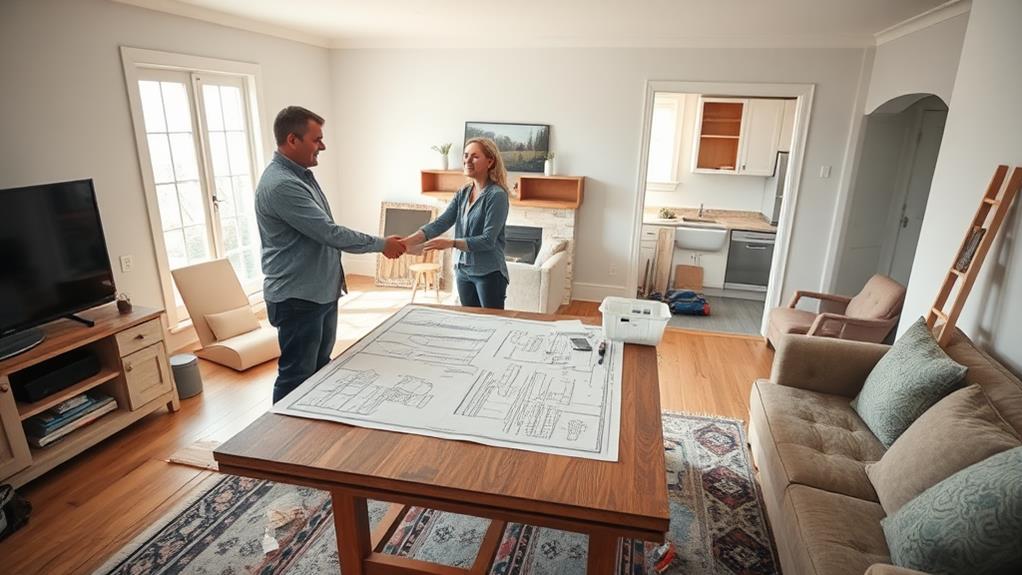Creating a realistic timeline for your home renovation project involves several key phases. Start with thorough planning and research, followed by design and permitting. Next, carefully select and hire contractors. The construction phase typically includes demolition, structural work, plumbing, electrical, HVAC, insulation, and drywall installation. Finally, complete final touches and inspections. Each phase requires different timeframes, with the entire process potentially spanning several months. Factors like project scope, complexity, and unforeseen issues can affect the timeline. Understanding these stages and their durations helps set realistic expectations and ensures a smoother renovation journey. Dive deeper to master the art of renovation planning.
Planning and Research Phase

Anyone embarking on a home renovation project should begin with a comprehensive planning and research phase. This crucial stage typically spans 2-4 weeks and involves several key steps.
First, homeowners should clearly define their renovation goals and priorities. This includes identifying must-have features, desired aesthetic changes, and functional improvements.
Next, conduct thorough research on design trends, materials, and potential contractors. Utilize online resources, home improvement magazines, and local showrooms to gather ideas and inspiration. Simultaneously, assess your budget and explore financing options if necessary. Create a detailed spreadsheet outlining estimated costs for materials, labor, and unexpected expenses.
During this phase, consult with professionals such as architects, interior designers, or general contractors to refine your vision and ensure feasibility. They can provide valuable insights on local building codes, permit requirements, and potential structural limitations. Additionally, consider the project's timeline and how it may impact your daily life. Plan for alternative living arrangements if needed, especially for extensive renovations. By investing time in this initial phase, you'll set a solid foundation for a smoother, more efficient renovation process.
Design and Permitting
Diving into the design and permitting phase, homeowners can expect this stage to last approximately 4-8 weeks, depending on the project's complexity. During this period, you'll work closely with architects or designers to finalize your renovation plans. This involves creating detailed blueprints, selecting materials, and making crucial decisions about layout and functionality.
Once the design is complete, the focus shifts to obtaining necessary permits from local authorities. This process can be time-consuming and may require multiple submissions or revisions to meet building codes and zoning regulations. It's essential to factor in potential delays due to bureaucratic processes or requests for additional information.
To streamline this phase, consider the following:
- Hire an experienced architect or designer familiar with local regulations.
- Prepare a comprehensive list of desired changes and priorities.
- Research local building codes and zoning laws in advance.
- Submit permit applications as early as possible.
- Be prepared to make adjustments to your plans if required by local authorities.
Contractor Selection and Hiring

Selecting and hiring the right contractor is a crucial step in the home renovation process, typically taking 2-4 weeks. Begin by researching local contractors, reading reviews, and asking for recommendations from friends and family.
Create a list of potential candidates and request detailed bids from at least three of them.
When reviewing bids, compare not only prices but also the scope of work, materials, and timeline. Schedule interviews with your top choices to assess their communication skills, experience, and understanding of your project. During these meetings, ask for references and examples of similar projects they've completed.
Once you've chosen a contractor, negotiate the terms of the contract, including payment schedules, project milestones, and contingencies for unexpected issues. Ensure that all details are clearly outlined in a written agreement. Before signing, verify that the contractor is licensed, insured, and bonded.
After finalizing the contract, work with your chosen contractor to establish a detailed project schedule. This timeline should include start and end dates for each phase of the renovation, as well as any potential delays due to material delivery or subcontractor availability.
Construction and Installation Process
The construction and installation phase marks the beginning of tangible progress in your home renovation project. This stage typically involves several key steps, each with its own timeline.
Demolition, if required, usually takes 1-2 weeks, depending on the project's scope. Structural work, including framing and any necessary repairs, can take 2-4 weeks.
Plumbing and electrical rough-ins follow, spanning 1-2 weeks each. HVAC installation may run concurrently, taking about 3-5 days. Insulation and drywall installation generally require 1-2 weeks, followed by 1 week for taping and mudding. Painting can be completed in 3-5 days for an average-sized home.
Flooring installation varies based on material choice, typically taking 3-7 days. Cabinet and countertop installation usually spans 1-2 weeks. Fixture installations, such as lighting and plumbing fixtures, generally take 2-3 days. Final touches, including trim work and hardware installation, can be completed in about a week.
It's important to note that these timelines are estimates and can be affected by factors such as material availability, unforeseen issues, and the complexity of your specific project.
Final Touches and Inspection

As the renovation nears completion, final touches and inspection become crucial steps in ensuring the project's success. These stages typically occur during the last 1-2 weeks of the renovation timeline and involve several key activities.
Final touches include painting touch-ups, installing hardware and fixtures, and addressing any minor imperfections. This phase also encompasses thorough cleaning of the renovated space, including removal of construction debris and dust. Simultaneously, landscaping work may be completed to restore outdoor areas affected by the construction process.
The inspection phase is critical for verifying that all work meets building codes and safety standards. This usually involves multiple inspections by local authorities, covering electrical, plumbing, and structural elements. Additionally, a final walk-through with the contractor allows homeowners to identify any remaining issues or concerns.
It's important to allocate sufficient time for these final stages, as unexpected delays can occur. Homeowners should be prepared to address any last-minute adjustments or corrections identified during inspections. Once all inspections are passed and final touches are complete, the renovation can be considered officially finished, allowing residents to fully enjoy their newly renovated space.
Frequently Asked Questions
How Do I Handle Unexpected Delays or Setbacks During the Renovation?
To handle unexpected delays or setbacks during renovation, maintain open communication with contractors, reassess priorities, adjust timelines accordingly, and have contingency plans in place. Stay flexible, anticipate potential issues, and allocate extra time and budget for unforeseen circumstances.
What Are Some Common Hidden Costs in Home Renovation Projects?
John discovered a $5,000 plumbing issue during his kitchen remodel. Common hidden costs in home renovations include structural repairs, code compliance upgrades, pest damage remediation, asbestos removal, and unexpected material price increases. Always budget for contingencies.
Can I Live in My Home During the Renovation Process?
Living in your home during renovation is possible but depends on the project's scope and your tolerance for disruption. Consider factors like noise, dust, lack of utilities, and safety concerns. Some homeowners opt for temporary accommodation during extensive renovations.
How Do I Manage Noise and Dust During the Renovation?
To manage noise and dust during renovation, implement soundproofing measures, use dust barriers, and schedule noisy work during appropriate hours. Employ air purifiers, maintain proper ventilation, and regularly clean affected areas. Communicate with contractors to minimize disruptions and ensure adherence to dust control protocols.
What Should I Do With My Pets During the Renovation?
Wondering how to keep your furry friends safe during renovations? Consider boarding your pets or arranging for them to stay with friends. If they remain at home, create a quiet, secure space away from construction areas and potential hazards.
Conclusion
A well-planned home renovation is akin to a symphony, with each phase harmoniously leading to the next. Just as a conductor guides musicians through a complex piece, a thoughtful timeline orchestrates the renovation process. Research indicates that projects with detailed timelines are 25% more likely to finish on schedule. By adhering to a realistic timeline encompassing planning, design, permitting, contractor selection, construction, and final touches, homeowners can transform their vision into reality while minimizing stress and unexpected delays.

